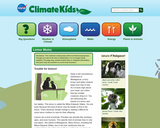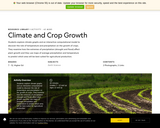
This parent guide supports parents in helping their child at home with the 6th grade Science content.
- Subject:
- Science
- Material Type:
- Reference Material
- Vocabulary
- Author:
- Kelly Rawlston
- Letoria Lewis
- Date Added:
- 10/11/2022

This parent guide supports parents in helping their child at home with the 6th grade Science content.

This resource accompanies our Rethink 6th Grade Science course. It includes ideas for use, ways to support exceptional children, ways to extend learning, digital resources and tools, tips for supporting English Language Learners and students with visual and hearing impairments. There are also ideas for offline learning.

This interactive activity demonstrates and provides explanation for how acid rain affects aquatic ecosystems and how certain species react to decreased water quality as pH becomes lower. The activity also explains the pH scale as a measure of acidity.

This lesson plan includes two activities designed to demonstrate the effects of acid rain on physical structures such as rocks, buildings, and statues and on living organisms (plants). In the first activity students will make observations after dropping samples of water and vinegar on chalk. In the second activity students will plant bean seeds to produce three separate bean plants. One plant will be given only water; one plant will be given only vinegar; one plant will be given a 50/50 water/vinegar solution. Students will form hypotheses, and then make observations and collect and graph height data as the plants grow.

In this lesson, students determine the particle size and composition of a sample of soil. Soil composition determines many characteristics of soils, such as infiltration rates (the rate at which water moves into a soil), percolation rates (how fast water moves through the soil), settling rates (how fast sediments sink to the bottom of a body of water), oxygen content, and the ability of the soil to support plant and animal life.

In this lesson, students identify which factors in an environment are biotic or abiotic factors and evaluate their effect on other organisms living within the environment.

In this lesson, students understand how water moves through different types of soils.

In this lesson, students create a visual representation of a habitat. Students should be able to explain the biotic and abiotic factors in their habitat, how those factors affect the organisms they are displaying in their habitat, the flow of energy through their habitat, and the soil and water conditions in their habitat.

Students will engage in and design an aerial glider from a list of materials that will be provided for them. An aerial glider is a mobile vehicle that is suspended in air for a given amount of time, and it travels a targeted distance.This vehicle will demonstrate animal adaptations and how their wings are beneficial for successful flight of that creature in their biomes. Knowledge of these concepts will be crucial for industry related fields such as mechanical, electrical and additive manufacturing engineering in both the public and military sectors. Students will learn the hard and soft skills necessary to be globally competitive citizens and perform at the highest standard in various careers. This lesson should be taught at the conclusion of the ecosystems unit as students will need prior knowledge of animal adaptations and how they must adjust to various environments in order to survive.

Students analyze a map of the North Polar region, test their knowledge of the Arctic, and brainstorm examples of the interconnectedness of life in this region with life around the world.

Students will conduct simple investigations to observe plant responses to light.

In this activity, students will experiment with how you can use light as a variable to determine its effect on the growth of plant seeds.

Students will work in groups and research their designated terrestrial biome. Students will research abiotic and biotic factors about their biome. Students will create a digital presentation of their biome using Haiku Deck. The presentation will summarize how the abiotic and biotic factors interact in their biome. Students will then use the collected data from the presentations to create food chains and food webs for their designated biomes.

Students investigate the interactions that take place among several variables of a closed ecosystem simulation.

This article discusses the challenges facing a species of lemur in Madagascar. Due to atypical rain patterns resulting from climate change, the survival rate of the offspring of these lemurs is decreasing. The Climate Kids website is a NASA education resource featuring articles, videos, images and games focused on the science of climate change.

Students explore climate graphs and an interactive computational model to discover the role of temperature and precipitation on the growth of crops. They examine how the extremes of precipitation (drought and flood) affect plant growth and they use maps of average precipitation and temperature to predict which area will be best suited for agricultural production.

Students will investigate how climate affects soil and its formation. The inquiry activity will demonstrate how soil temperature is affected by water content, plant or mulch cover, and aspect.

In this activity, students will examine how ectothermic animals, such as ghost crabs, regulate their body temperature by moving to different environments.

Students watch a video about hydrothermal vents and then use a map of plate tectonics to identify and mark where in the world the vents are most likely to be found.

Students will discuss / research the pollutants that may be present in their area and choose one to bioassay on seed germination. After choosing a pollutant and having the teacher approve it, they will design an experiment to test its effects on your seeds.